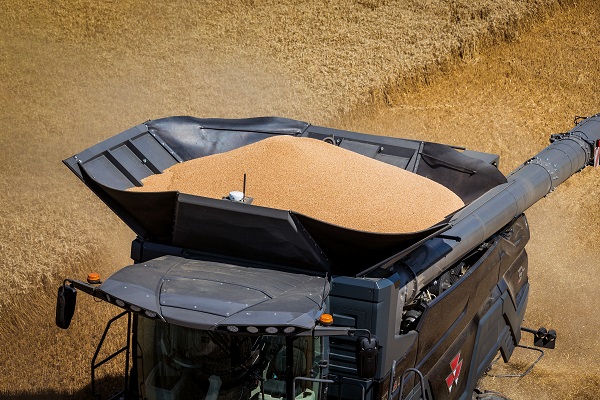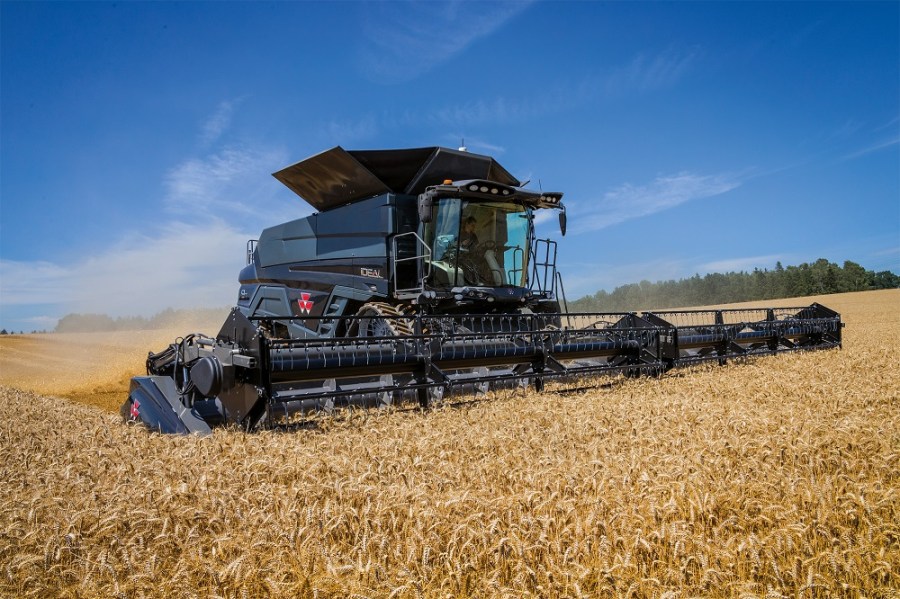A new graphite grey machine is set to appear in UK fields for harvest 2018. CPM travels to Italy for the worldwide launch of the brand-new Fendt and Massey Ferguson combine range.
It’s by far the biggest development programme we’ve ever undertaken.
By Tom Allen-Stevens
A completely new range of combines promising a “step change” in performance and efficiency has been launched by AGCO. The graphite grey Ideal series 7, 8 and 9 rotary machines will be badged as either the Ideal from Massey Ferguson or the Fendt Ideal in the UK, but either brand will be the same machine, and will be priced identically.
Unveiled at a global launch earlier this month at the machinery giant’s combine factory at Breganze, Italy, it’s the first significant step AGCO’s taken into having a single-platform machine to serve its family of brands. Developed over five years and passing through five prototypes at a cost of $200 million, 50 machines have been tested on crops around the world, notes Eric Hansiota, AGCO’s senior vice president of Global Harvesting.

A 17,100-litre grain tank and unloading speed of 210 l/sec are among features designed to deliver a step-up in field performance and efficiency.
“It’s by far the biggest development programme we’ve ever undertaken. We’ve done 195 lab tests on every system and component we’re using, bringing in the relevant engineering expertise from the different companies within AGCO. But we’ve also involved customers and dealers – their fingerprints are on the design, and it’s their demands we’ve delivered with the Ideal combine.”
While a 9.8-litre AGCOPower engine drives the 450hp single-rotor Ideal 7, MAN 12.4 and 15.2-litre six-pot in-line engines push out 538hp and 647hp of grunt to the Ideal 8 and 9 respectively. At 4.84m, The Dual-Helix rotor fitted to the larger two machines is claimed to be the longest in the industry, and provides 31% more threshing area than the nearest competitor.
Another step-up is the grain tank, with the 17,100-litre option around 18% larger than its nearest rival. Combined with the Streamer unloading auger, that pushes the grain out at up to 210 l/sec (claimed to be 32% faster than the next best), this brings a significant step-up in field-logistics efficiency, says Eric.
There’s also improved fuel efficiency, from the low-pressure threshing system, for example, claimed to be gentle on the crop and running at a low rpm, while a simple drive system incorporates a total of just 13 belts. This feeds the crop through the rotors to the Idealbalance grain pan. Made from lightweight polymer, there are two curved collection pans, profiled to even out the crop over 4.06m² of sieve area and providing slope compensation up to 15%.
A key feature in these new machines is the technology that monitors, auto-adjusts and wirelessly transmits real-time data. “This machine has eyes and ears,” notes Stefan Caspari, vice president of AGCO’s Fuse Connected Services.
“There are 52 Mass Accoustic Detention sensors and a grain-quality camera that allow automatic regulation of the machine’s rotor, fan speed and sieve settings. The operator uses a simple iPad interface to set preference for three key parameters –grain losses, broken grains and sample cleanliness. The combine then self-adjusts, fine-tuning rotor speed, fan speed and sieve openings to create the ideal settings.”
Performance data and settings can be streamed wirelessly to a nearby manager in the field in real time, who can transfer settings to other machines, where more than one combine may be working in the same field. “It means you can have one experienced operator who maintains command, working with a less experienced operator.”
A nifty new option is AutoDock. Once the feeder housing, that can tilt, connects to the header, you just tap a button in the cab and the header drive, hydraulics and electrics automatically hitch up in just 5 secs. The housing itself has a lifting capability of 6.5t – easily enough to hoist the PowerFlow table, available in widths up to 12.2m.
Another notable feature is the Ideal’s width. With either 800 tyres or 660mm tracks, this is just 3.3m, notes Francesco Quaranta, vice president of AGCO’s Global Harvesting. “That’s the only combine above 550hp that stays below a 3.3m road width. It can travel at up to 40km/h on the road, while in the field there’s a generous 2.4m² footprint on tracks.”
The brand-new combines are set for launch in Europe in 2018, and the plan is to manufacture 2500 units annually, with 800-1000 of these destined for Europe and the Middle East. They’ll come with AGCO’s existing pledge that an engineer will never be more than a three-hour drive from one of its combine harvesters, and parts are guaranteed to arrive within 24 hours.
There’ll be a host of options and technology upgrades available across the range, and it’ll be these, along with the individual dealer support, that will probably define whether the model purchased carries Fendt or MF branding. “Will the combines be different? Yes, but that’s because customers have differing requirements, but they will be priced identically,” says Francesco.
In addition, AGCO is planning to launch a proactive maintenance service in the New Year, reveals vice president of parts and aftersales Boris Schoepplein. “This is a $50 million investment, including a new centre which will receive data analytics on all machines equipped and opted in to the new service. This will tell our engineers if there are any issues or problems with a machine even before the operator becomes aware,” he says.




